Hey, we’re back!
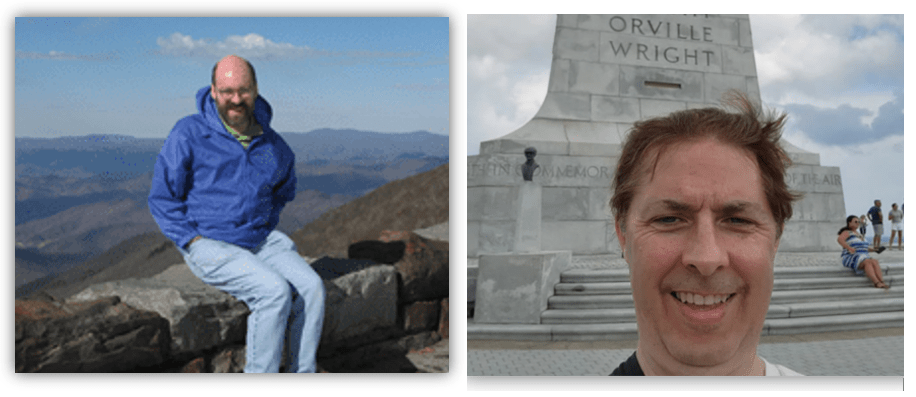
It’s us!
Chuck and Ozmoe:
The intrepid duo of TNOCSers talking about the state where we live.
We left off last time in the middle of what’s the middle of the state, the Piedmont, and heading east from Charlotte and the Triad.
That’s where Interstates 40 and 85 meet and run concurrently for 32 miles on a busy stretch of highway. Nearly every interchange has plenty of restaurants, gas stations, hotels and other amenities off the exits. Some have more than that. We’re especially dreading:
The opening by 2027 of the state’s first Buc-ee’s in Mebane

The company has vowed the mega-convenience store will be even bigger than the already massive one they have on I-95 just 35 miles from the state line in South Carolina. Oh boy!
Moving on, let’s get to talking about where we live. Follow I-40 southeast as I-85 veers northeast at Hillsborough to reach us at one of …
The Many Sides of the Triangle
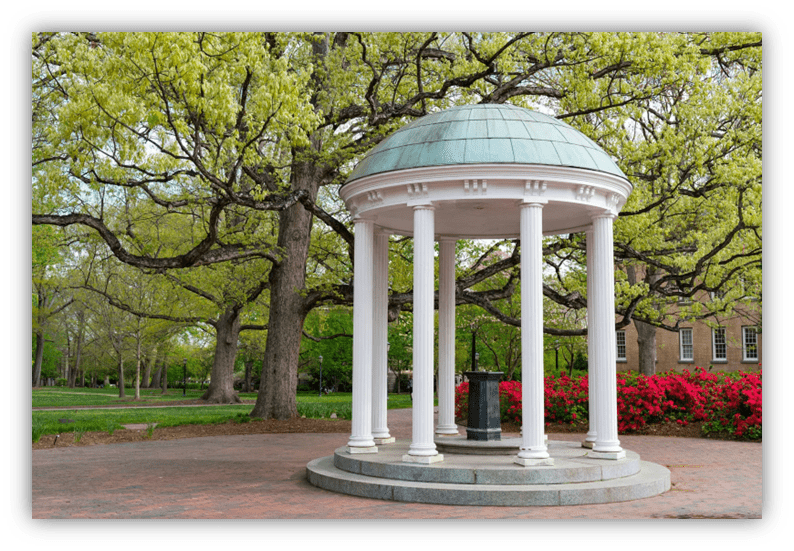
Ozmoe:
The first municipality you’ll hit on this route is Chapel Hill, my hometown.
I was born in Winston-Salem in the Triad, but my family moved here when I was still an infant. So, I consider myself a native of the city.
The reason for our move was the main one for many here.
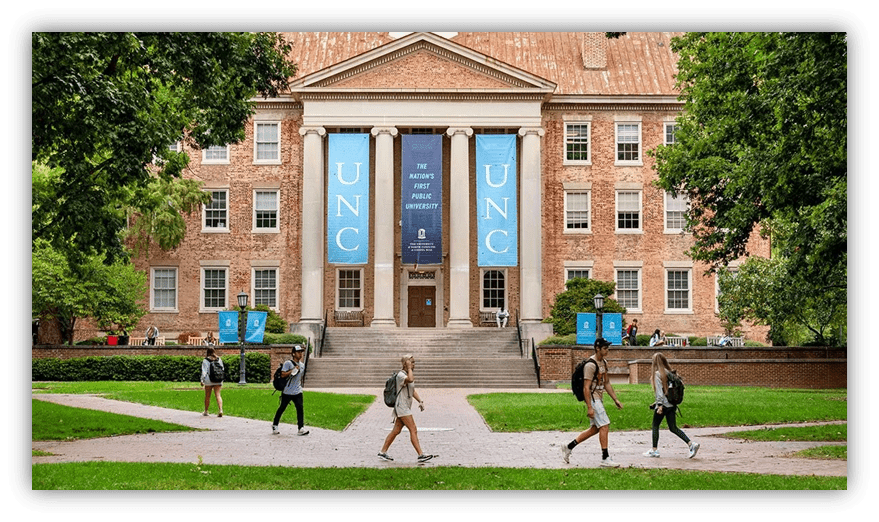
My father went to teach at the University of North Carolina, more commonly known as UNC.
Recognized as the first public university in the United States as it was chartered in 1789, UNC has many claims to fame. I usually tell people, “That’s where Michael Jordan played college basketball,” and then they nod with approval.
There’s been several turf battles over the year between the “town and gown” regarding their growth plans. Still, Chapel Hill and UNC have coexisted relatively peacefully over the years.
The bigger challenge for Chapel Hill has been trying to handle the increased population from all its success.
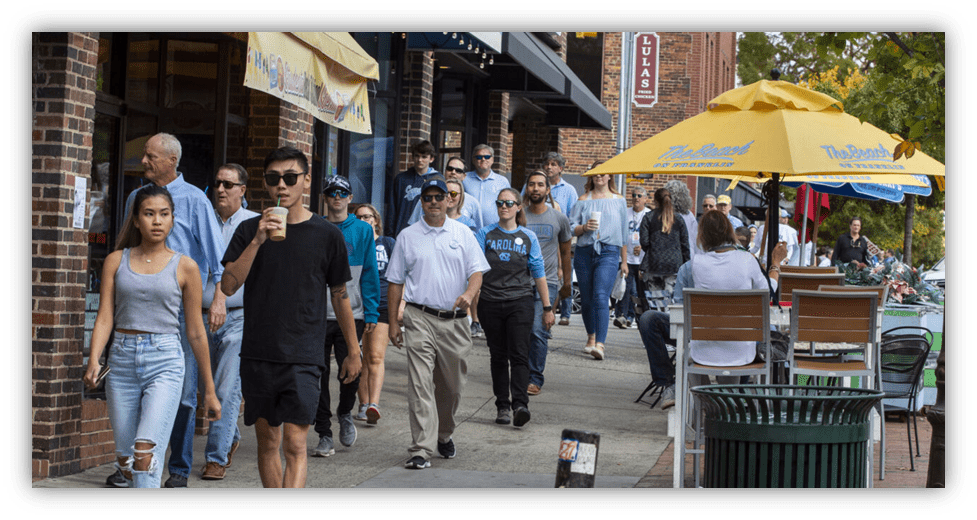
Despite several “slow growth” policies in place like a rural buffer in place to maintain agricultural land near the city, people keep coming.
When I grew up, the town had only one public high school. Now it’s got three. Incidentally, our current governor was in that high school the same time I was, a year behind me.

This is me with Gov. Josh Stein a few years ago before he reached his current post.
That’s just one example of many changes around here. Chapel Hill now is the 17th most-populated city at over 65,000 residents.
Part of the reason for the growth is that Chapel Hill is considered one of the three points of “the Triangle,” with Durham and Raleigh as the other two.
The designation is a contraction of the full nickname, the Research Triangle.
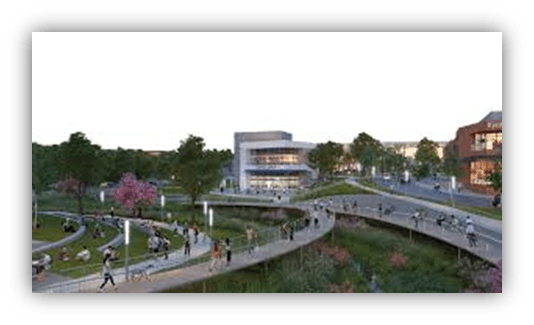
It’s a business and research park created in the late 1950s by area leaders who realized students were graduating from UNC in Chapel Hill, Duke in Durham and N.C. State in Raleigh only to leave the area.
The Research Triangle helped keep talented graduates in the area despite supposed rivalries among the three universities.
Such rivalry is more hype than fact. You’ll see several homes flying flags of two as a sign the couple lives in a “divided house.”
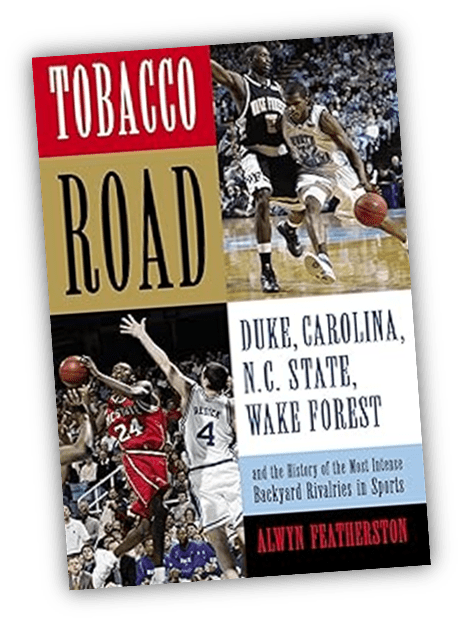
To me, the most hysterical element in the Duke vs. UNC rivalry is when sports pundits call it a “Tobacco Road” battle.
I dare you to find an uncured tobacco leaf growing anywhere between Chapel Hill and Durham nowadays!
Interestingly, I moved about a decade ago from Chapel Hill to Durham because of the area’s growing pains. I lived in a condo near where plans were announced to open the area’s first Wegmans grocery store. I knew it would be popular, so I made plans to find a house and secured a great deal on one, six miles away in Durham.
By the way, I do shop at that Wegmans some. Go figure.
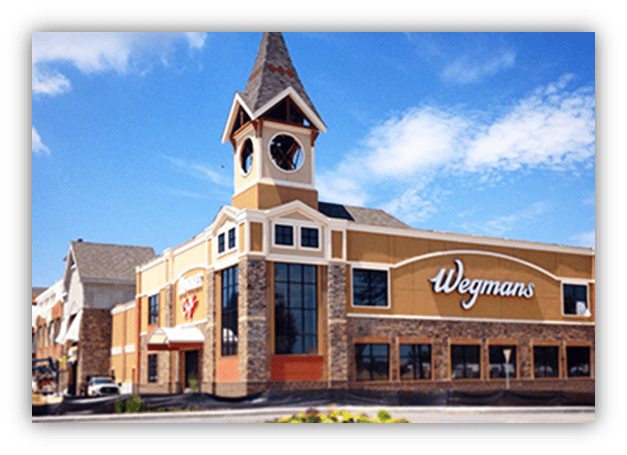
I’m not the only one who’s moved to the home of the famed Durham Bulls minor league baseball franchise, the beautiful Duke Chapel and many other attractions. Durham now has more than 304,000 inhabitants. That leaves it just 2,500 or so shy of surpassing Greensboro as the state’s 3rd most populated city behind Charlotte and Raleigh.
Speaking of Raleigh, I’m sorry I’ve run on so long talking about Chapel Hill and Durham. Chuck, what about your adopted hometown?
Chuck:
When I moved from Indiana in late 1993, I was amused at how natives and longtime residents would talk about leaving Raleigh to see a show at UNC-Chapel Hill or eat at one of Durham’s fabulous restaurants as if it were some sort of road trip.
I guess that’s because I grew up in Chicago, and a 45-minute trip from the city to the suburbs was typical.
That said, the Triangle’s population has mushroomed in the past three decades, to where more than 2 million people live in the nine-county Raleigh-Durham-Cary statistical area as of 2020.
The “Town” of Cary, as it still calls itself, is the state’s 7th-largest city.
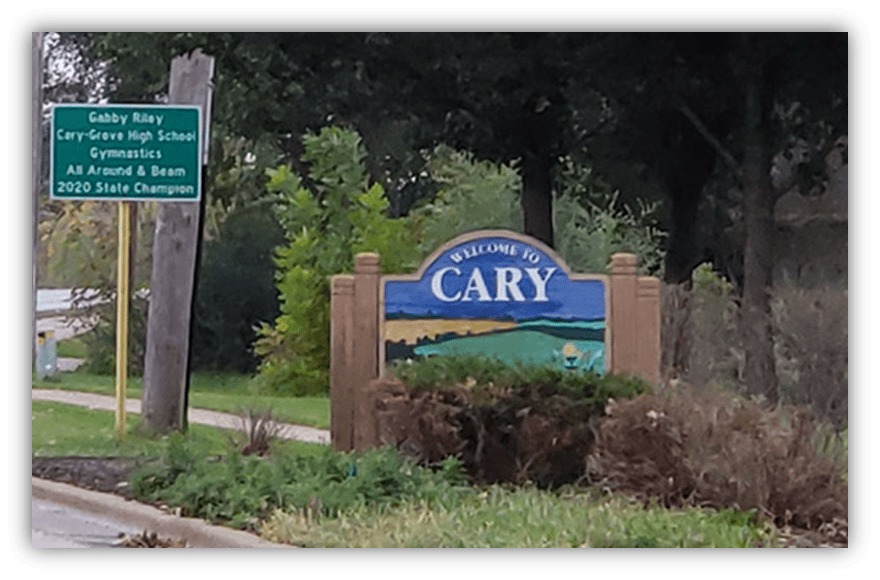
I dare you to drive in its sprawl and not get lost. The town’s name is traditionally mocked as an anagram for “Containment Area for Relocated Yankees.” (That’s a misnomer, mainly because there are at least as many folks who moved from the northeast to settle in Raleigh, the state’s capital.)
My husband Tom is the country mouse, while I’m the city mouse.
He loves Raleigh because he first moved here in the 1970s and remembers it as the small-town capital it was.
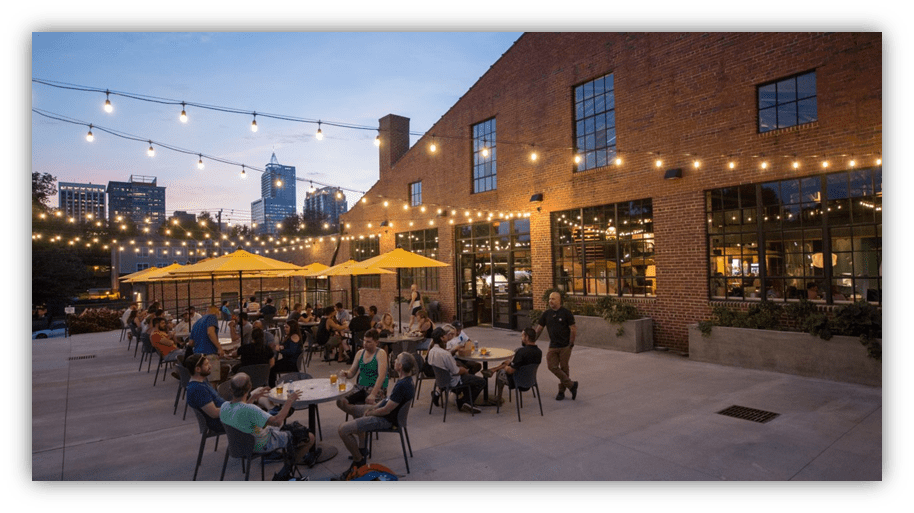
I love it because it has become the metropolis I enjoy.
Amid lots and lots of change, we both feel comfortable navigating the familiar arteries even as old buildings and lots give way to skyscrapers and condos.
N.C. State University’s campus is a big draw. So too are the nearby State Farmer’s Market and Dorothea Dix Park, an urban campus on a former plantation that later became the state’s first mental-health facility.
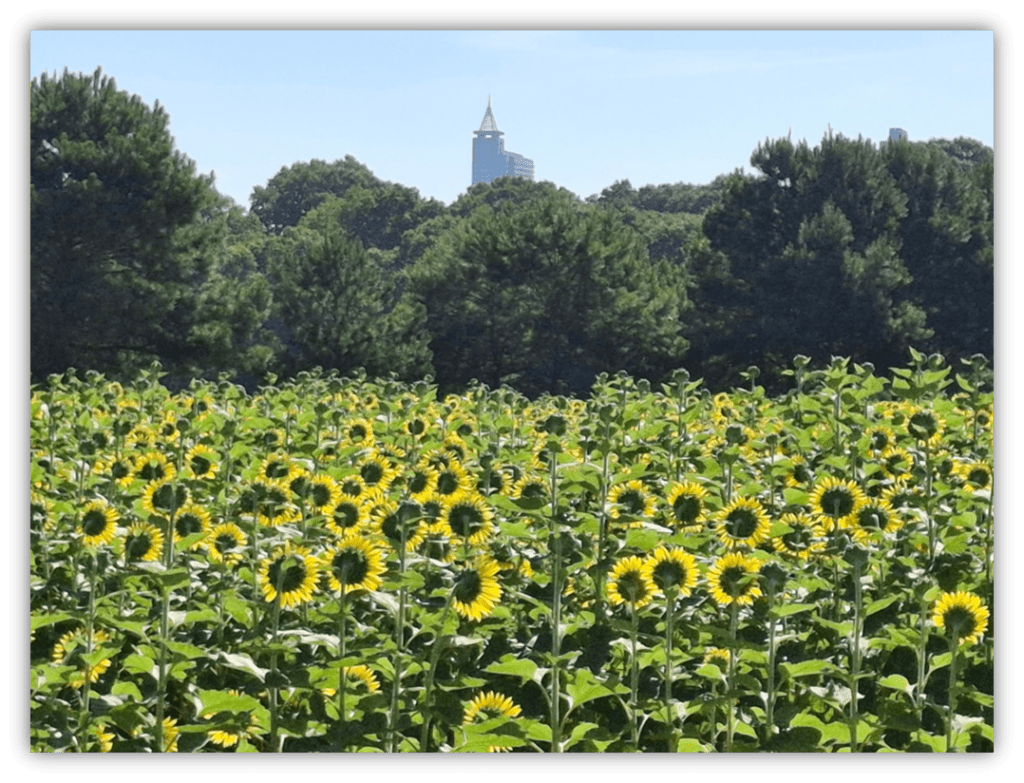
When I moved to the area, Chapel Hill and Durham were the default locations for outstanding restaurants. Although there’s still a host of great dining options in the western part of the Triangle, Raleigh has caught up in the past three decades. Nationally recognized chefs such as Ashley Christensen and Empire Eats owner-operator Greg Hatem’s half-dozen restaurants draw in crowds of all ages.
The biggest metamorphosis has taken place north of downtown off the I-440 “Beltline.” What three decades ago was a fading mall was reimagined by developer John Kane and others as “Midtown.” Business, condos, restaurants, and open areas for small concerts pull in an audience of young and middle-aged adults. It’s entirely possible to sit at a Midtown restaurant, look up at nearby skyscrapers, and think you’ve transported to L.A. or Atlanta. (That is, if you forget you ordered sweet tea and hush puppies.)
Ozmoe:
I’d like to add before we leave the Triangle that as fast as it’s growing, it’s impacting the surrounding areas even more.
South of Chapel Hill and Durham and southwest of Raleigh in Chatham County, the Disney corporation has announced Asteria, a planned 1,500-acre project that will include approximately 4,000 residential uni
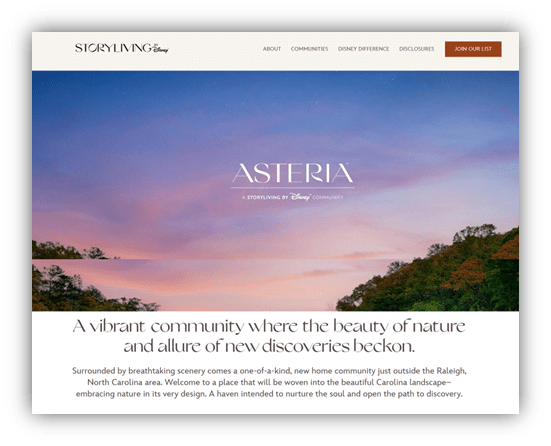
It’s intriguing me enough as a possible retirement spot that I’ve signed up for email updates. Alas, not much to report so far.
Then there’s the explosion of activity in Johnston County, located southwest of Raleigh. Its current population of over 256,000 is expected to reach 290,000 or so by 2030. Many people are finding it a favorable option for living between the capital city and the coast. Which leads us to our final region of the state:
Heading East
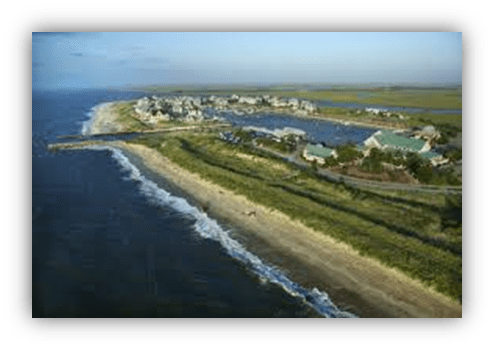
The official designation of most counties between I-95 eastward to the Atlantic Ocean is the Coastal Plains, but most of us just refer to it as “Eastern North Carolina.” Or just “the East” or “Down East,” depending on the location.
The region has several claims to fame.
- It boasts about its style of pork barbecue. Usually served “chopped,” meaning finely shredded, it involves cooking a whole hog using a vinegar-and-pepper sauce. This is opposed to the more tomato-based sauce focused on the pork shoulder used in Western or Lexington-style barbecue.
- Its terrain is also much flatter and swampier than the Piedmont. I distinctly remember learning in elementary school that eastern North Carolina is so flat that the land rises only a foot every mile on average.
- Also, the region is far more rural than the rest of North Carolina. The towns that do pop up sparsely in the East are usually small.
There are only three municipalities in eastern North Carolina not at the coast with a population over 50,000. Two, Rocky Mount near I-95 and Jacksonville near the coast, slightly lost population over the past year, per the latest Census results.
The region’s most populated city is Greenville (91,000+ residents).
That’s not too surprising given that it’s home to ECU (Eastern Carolina University).
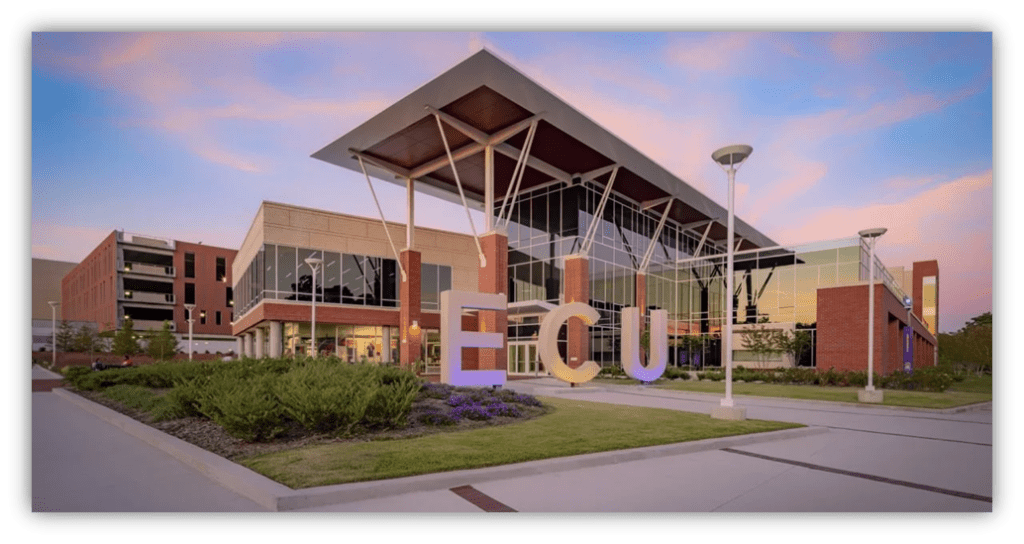
It’s located in Pitt County, which at 176,000 residents and counting has more people than any other county between I-95 and the coast.
Sadly, most of the northeastern counties are losing population.
When tobacco and textiles died out in this area, so did a lot of opportunities. These largely poor counties suffer from some of the worst health outcomes in the state. A state representative for the area has nicknamed it “Neglected Northeastern North Carolina” due to ongoing neglect and lack of investment.
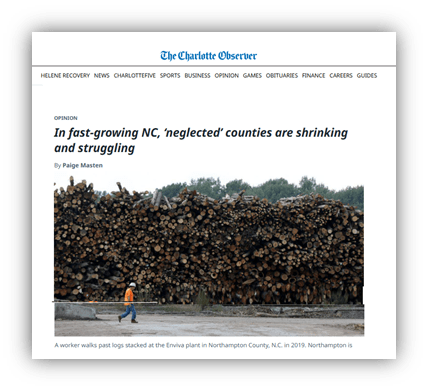
He’s trying to turn it around, but it’s going to take a lot of work.
Chuck:
North Carolina is home to a dozen of the nation’s historically black colleges and universities.
While several are in the Triangle, one – Elizabeth City State University – is in the northeastern part of the state. ECSU is one of five state universities involved in the “N.C. Promise” program, which caps tuition for undergraduate in-state residents at $500 per semester.

Tom and I enjoy taking day trips to coastal towns such as Edenton or Oriental, stopping at a local diner or restaurant for lunch, and walking around the area to soak up the sun and the ambiance.
It’s a nice summer getaway from Triangle suburbia.
If you’re at all familiar with chef and restaurateur Vivian Howard, she’s a native of the Kinston area in the eastern county of Lenoir. Her restaurants – from the dearly departed Chef and the Farmer or the Boiler Room to the current The Counter – are always worth the trip
First in Flight with the Wrights

Ozmoe:
Most people visiting Eastern North Carolina usually are bound for the beaches.
The northern part of the coast consists of what’s known as the Outer Banks.
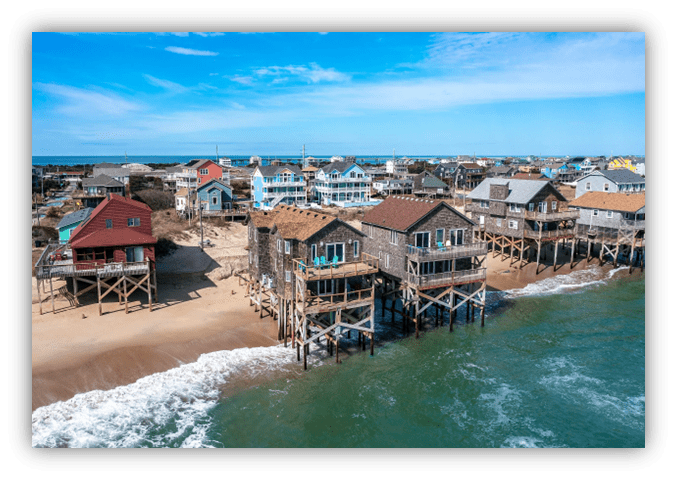
It’s the part that juts out to the Atlantic Ocean the most, and not surprisingly it usually sustains a lot of damage from tropical storms and hurricanes.
Even so, the views and vibes of the seaside towns are stunning, and the relative lack of development makes them a popular tourist destination.
One of them is Manteo.
Follow U.S. Highway 64 west from there and you’ll cross the state the longest way possible, with one of the last stops in the mountains being the small town of Murphy.
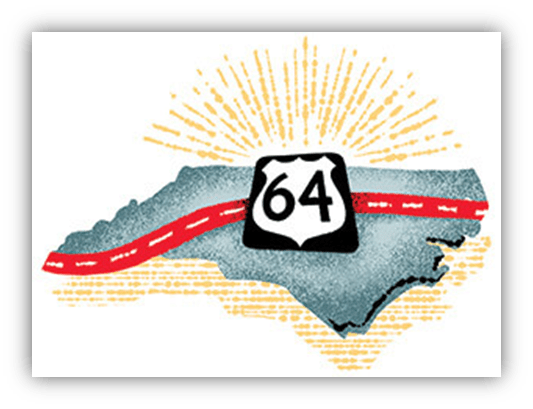
Hence the saying in the state, “From Murphy to Manteo.”
It may surprise you to know that a hefty share of beachgoers come from Virginia and points north rather than from the state itself. That’s because it’s more accessible than the long trek for most North Carolinians in the Mountains and Piedmont regions, with at least a four-hour drive. Given that, it’s not too surprising to learn that the northeast convenience store powerhouse Wawa opened its first North Carolina location at Kitty Hawk last year.
The most famous spot here is Kill Devil Hills, where the Wright Brothers were able to fly the world’s first successful airplane in 1903.
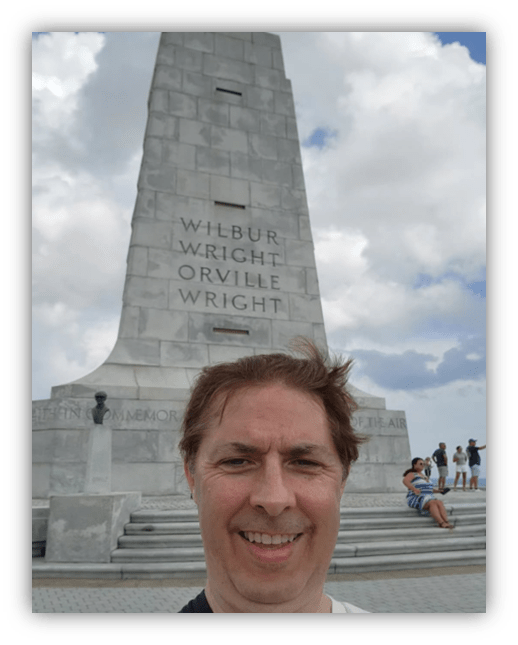
A national memorial exists on the site, and it’s definitely worth a visit.
Chuck:
This is the part of the state with which I’m least familiar.
Tom and I have been to Kill Devil Hills on a day trip. But I have no burning desire to go to Ocracoke, a very popular Outer Banks destination.
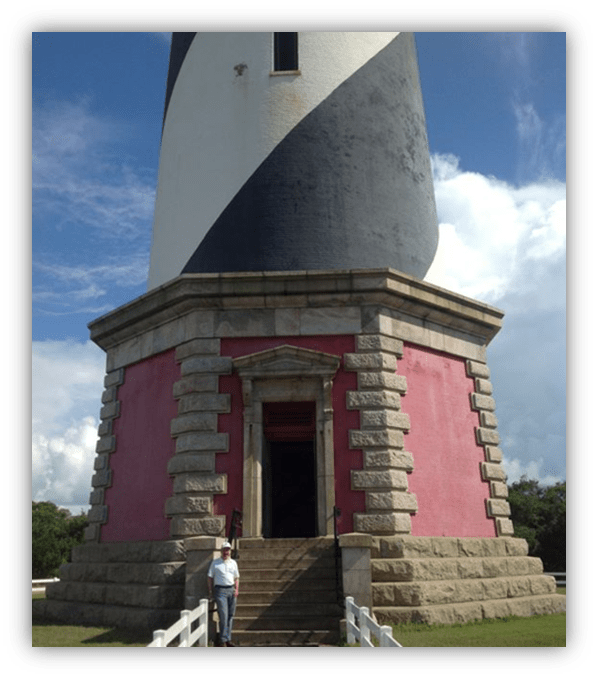
I will say that a trip to the Cape Hatteras lighthouse, also in the Outer Banks, is certainly worth your time.
It’s a beautiful sight – and survived a 1999 move from the encroaching Atlantic just fine.

The Rest of the Coast
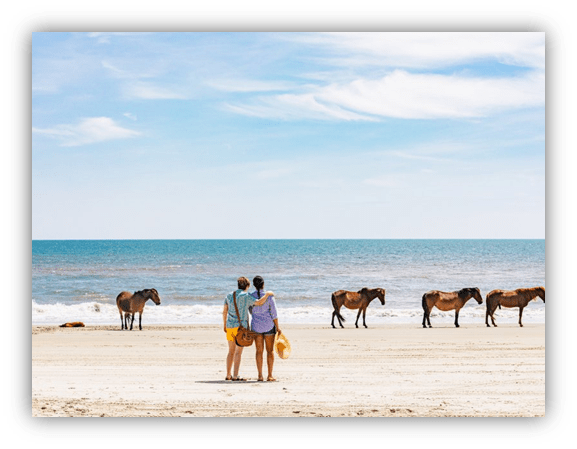
Ozmoe:
Where the barrier islands that comprise the Outer Banks end is a matter of dispute to some.
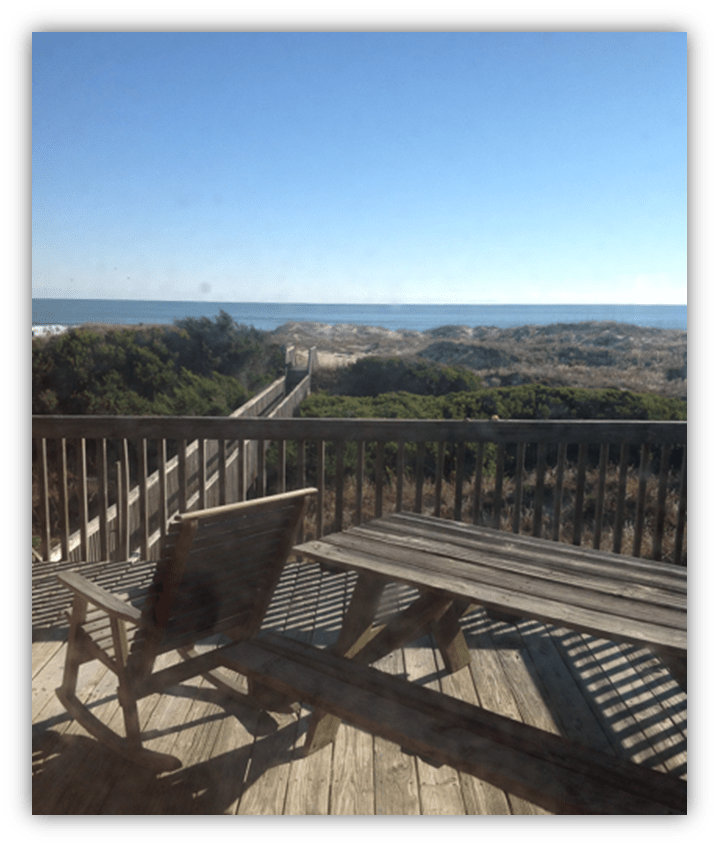
I’d say the beach islands are closer to the mainland—and therefore less “Outer”—starting at Emerald Isle, a beautiful beach community.
Many of the coastal communities from here down to the South Carolina border are charming. There’s not too much development, the cottages, condos and hotels are largely attractive, and there’s a laidback vibe overall. It’s fun to go fishing or swimming or just hang out and enjoy the breeze and the relatively warm water (during the summer at least).
The exception to this rule is Wilmington and the beaches surrounding it.
As the biggest coastal city in North Carolina, it’s home to a thriving community with plenty of attractions for visitors to enjoy.
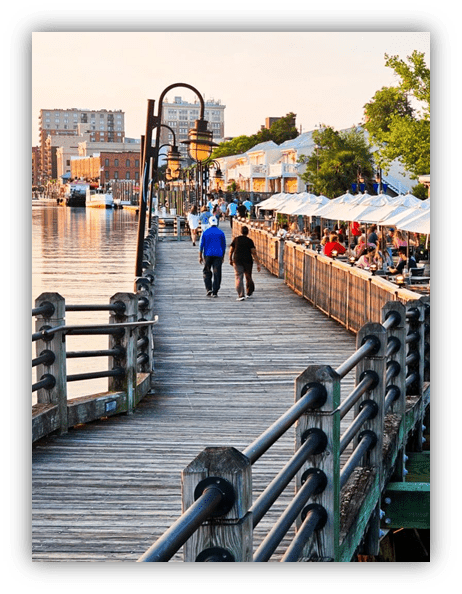
While getting to Wilmington by car isn’t exactly fun — its 92-mile stretch to I-95 on I-40 is the longest and most boring stretch of interstate highway in the state — it’s become the destination of choice to many.
What’s more, the 60 or so miles between it and the South Carolina border is fast growing as well too despite the constant threat of hurricanes. Many retirees find it especially enjoyable, being more affordable and less, well, crazy than Florida beach life. I’m tempted to join them in my golden years as well.
Chuck:
If I weren’t staying in the Triangle in retirement (a time I think may be closer for me, Ozmoe, than for you), I’d more likely head west to the mountains than east to the coast.
Having said that, I agree that Emerald Isle and the surrounding Carteret County offer a pleasant respite from the urban and suburban life we share in the Triangle.
Well, that’s our overview of North Carolina. We hope you enjoyed it. Maybe it’ll encourage you to come visit sometime and even see us.
If so, let us know. We’d love to have you!



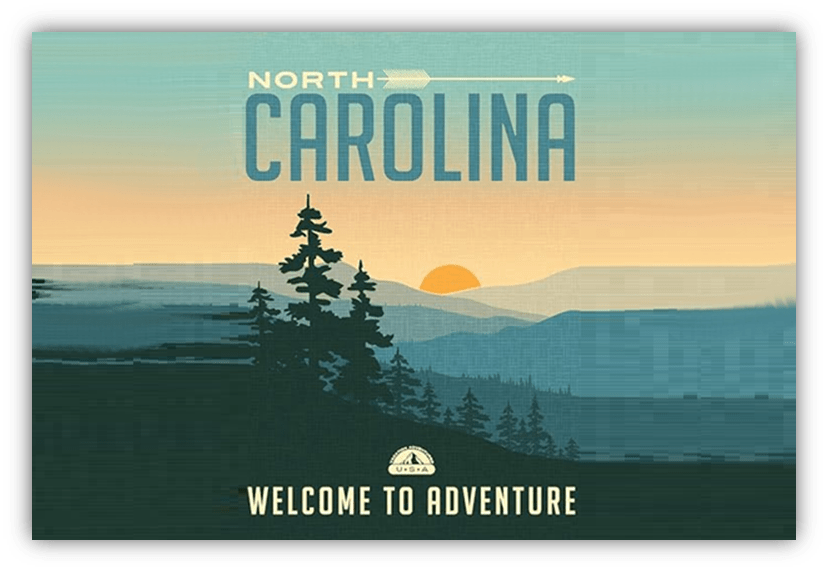
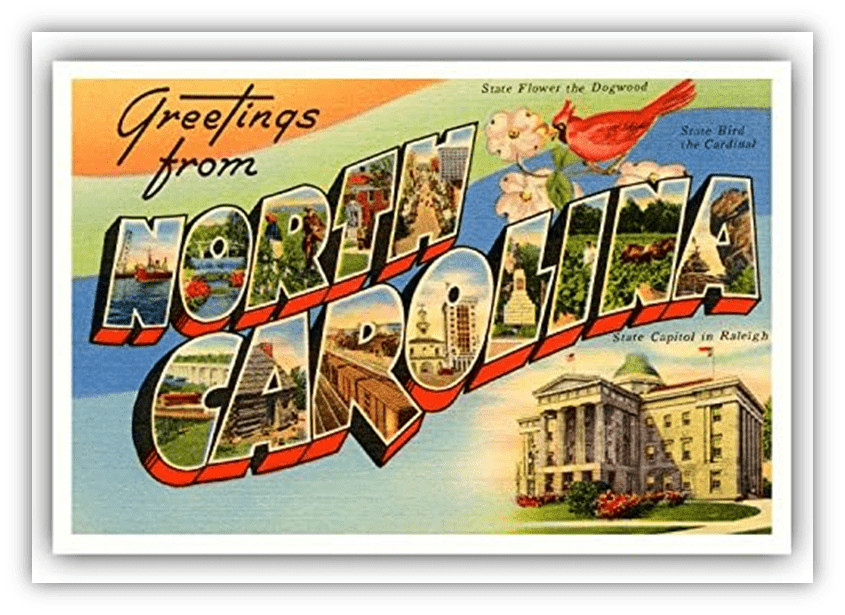


A Michael Jordan shout out was a nice way to start my day. I have not been to this part of NC. My brother and his wife spent a week in this area after dropping their son off at Duke for a Coack K basketball camp. They raved about it and I’ve wanted to go, so someday.
Nice job, guys. In the spirit of the state’s basketball prowess, great teamwork.
Oops ….. I meant “acronym” for Containment Area for Relocated Yankees, not anagram. Everyone needs editors, even (especially!) editors.
These are the parts of the state that I am more familiar with. When I would visit my dad in Rocky Mount in the early/mid 80s, sometimes we would fly into the Raleigh airport. I remember it being a pretty small airport…I’m sure that’s it’s so much bigger now.
Our favorite beach spot was Atlantic Beach. Seems that we spent a couple days there every summer. I don’t think I would be happy living at the beach, but it is fun to visit occasionally.
You guys almost make me want to go back! I probably could, since my soon-to-retire brother in law and sister just moved back to Fayetteville. Thanks for the virtual tour!
I love, love, love the Outer Banks. The first time that I was there, I was riding with my husband when he was a long-distance truck driver. He had a delivery to make in Kitty Hawk. I was utterly charmed by what I saw, and we immediately started planning our first vacation there.
I love using Google maps to look at towns, landscapes, anything of interest. Coastlines are a particular favourite.
The likelihood is that I’m not going to make it to North Carolina so viewing it online will have to do. Even before Chuck and Ozmoe’s guide I’d spent plenty of time looking over the Outer Banks. Its a fascinating area to take an online tour of, I can imagine the reality is captivating.
If David Gordon Green was born in North Carolina, the entire post would be about him. He’s an Arkansas native. Green went to the North Carolina School of the Arts at the same time as Danny McBride.
These are my ten favorite films shot in North Carolina, on location, not in a studio. Dino DeLaurentis had a studio in Wilmington. So, no Blue Velvet.
*Household Saints by Nancy Savoca would be #4, but it was shot in the same Wilmington studio. After DeLaurentis passed away, it was renamed the EUE/Screen Gems Studios.